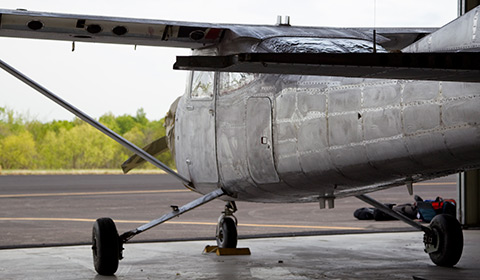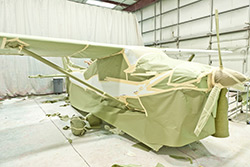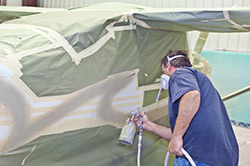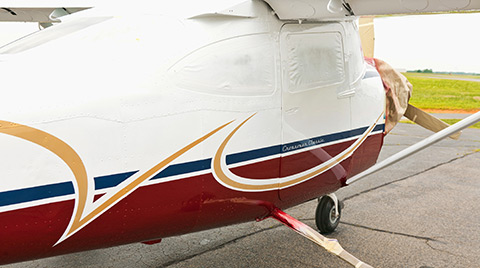AOPA 2011 Crossover Classic Sweeps: Beauty that’s skin deep
New paint makes all the difference
This year’s AOPA Crossover Classic sweepstakes airplane began its renovation process just eight short months ago. Now, as the once-bedraggled 1974 Cessna 182P enters the final stages of its transformation, there’s a rush to the end. Air Mod has completed its excellent interior upgrade work, and now the work shifts to the airplane’s new paint job.
The paint job may be last of the massive work packages, but perceptually it’s perhaps the most important. Why? First impressions carry great emotional weight, and the original paint job was most definitely a sight best seen from afar. You’ve no doubt heard of cars or airplanes being called “20-footers” or “50-footers” (references to the distances at which exterior flaws can’t be detected), but the beat-up, original lacquer finish on the sweeps airplane made it a solid “100-footer”—and maybe more than that. Well, all that’s coming to a swift end.
Boss Aircraft Refinishers, run by Bill Lucey and based at Rowan County Airport in Salisbury, North Carolina, has gone after the old paint hammer and tongs. I paid a visit to Lucey’s shop in late April to get a look at the painting procedure. It turned out to be quite a learning experience. There’s a whole lot more to painting an airplane than simply aiming a spray gun.

For the Crossover Classic, we decided to go with a new Sherwin-Williams Aerospace Coatings product: a line of base-, top-, and clearcoats the company calls its SkyScapes line. What’s the big deal with SkyScapes? The main advantage is faster drying times. And faster drying times means that a paint job can be finished in as little as two days. That’s because the airplane’s single base coat can be dry enough to permit masking and top-coat painting just two hours after being applied. And yet, the finishes’ final cure times are as long as 72 hours. This means there is extra time for application of stripes, N-numbers, and other paint-scheme elements. This is a big advantage, especially when dealing with a complex paint scheme. Having the longer final cure time also allows the last, clearcoat finish to bond properly to the paint layers beneath.
With some other paint processes involving multiple base coats and shorter cure times (as short as two hours), the danger is that paint can dry to the point of sealing off—and preventing the clearcoat from bonding. Now you risk a delamination of the clearcoat as it later separates from the paint.
SkyScapes is also eco-friendly because of its high density, or solidity as it’s called in the industry. This translates into less polluting aerosols, while at the same time providing high paint opacity with less paint. With the Crossover Classic, the paint process involved several steps. Sherwin-Williams technical service representative Steve Voisin was on hand at Boss to show off the new process. In brief, here’s how the work progressed after the airplane was cleaned, had its skin’s minor nicks and dings filled, and was treated with Sherwin-Williams’ corrosion-protective epoxy primer.
First, Voisin mixed up the SkyScapes “snow white” base coat, carefully checking the paint for the proper viscosity. Then Boss painters suited up, went into the paint booth, and shot the entire, single base coat in 25 minutes. This caused no small amount of excitement, because typically three base coats would be applied, with breaks in between to allow each coat to dry; ultimately this is about a three-hour process.

After waiting two hours for the base coat to dry, it was time for Paul Howes of Moody Aerographics in Ocala, Florida, to take center stage. Moody is one of the oldest decal and paint-mask manufacturers dedicated to the aviation industry. Howes helped the paint shop staff install the masks that will allow the Crossover Classic’s four-color paint scheme to take on the specifications set out by Craig Barnett of Scheme Designers—AOPA’s longtime source of paint scheme concepts.
 The 182 has a white primary color, plus burgundy, blue, and gold accent colors. Masking and taping for each color took two hours, and painting each color took about 15 minutes, with a two-hour waiting interval for each color to dry. Add up the application and drying times and you come up with an optimal paint completion time of 20 hours. Then came two final clearcoat applications, which each took another half hour to spray on, and 12 hours to dry. The clearcoat is important because it protects the paint from the damage caused by ultraviolet rays, dirt, and contamination by fuel, hydraulic fluid, and other chemical agents.
The 182 has a white primary color, plus burgundy, blue, and gold accent colors. Masking and taping for each color took two hours, and painting each color took about 15 minutes, with a two-hour waiting interval for each color to dry. Add up the application and drying times and you come up with an optimal paint completion time of 20 hours. Then came two final clearcoat applications, which each took another half hour to spray on, and 12 hours to dry. The clearcoat is important because it protects the paint from the damage caused by ultraviolet rays, dirt, and contamination by fuel, hydraulic fluid, and other chemical agents.
In all, from start to finish the job took 33 hours, spread over three days. That’s fast. Of course, completion times can vary. The more colors, the more complicated the design, and the more humid the conditions, the longer the drying and completion time. Using other paint processes, the same job would have taken a week or more. Other time savings come from the use of masks to delineate the stripes and N-numbers. It took two hours to mask off the sweepstakes airplane; marking the different color borders by hand would have taken two days. Some old-school paint shops may look down on masks, but advocates claim that masking provides more accurate paint details that better conform to a designer’s intentions.
 Painting the Crossover Classic was a congenial affair. Sherwin-Williams was anxious to show off its new product, a large group of the curious were on hand, Boss Aircraft Refinishers learned more about masking, pizza was served, and yours truly learned that painting an airplane properly is a science. “The temperature and humidity have to be right in order to get the best result,” Voisin said. In case you’re curious, the temperature in the Boss paint booth was 74 degrees Fahrenheit, the relative humidity was 71.8 percent, and the airplane’s skin temperature was 71 degrees. Almost ideal conditions.
Painting the Crossover Classic was a congenial affair. Sherwin-Williams was anxious to show off its new product, a large group of the curious were on hand, Boss Aircraft Refinishers learned more about masking, pizza was served, and yours truly learned that painting an airplane properly is a science. “The temperature and humidity have to be right in order to get the best result,” Voisin said. In case you’re curious, the temperature in the Boss paint booth was 74 degrees Fahrenheit, the relative humidity was 71.8 percent, and the airplane’s skin temperature was 71 degrees. Almost ideal conditions.
All that’s left is to let the airplane dry a bit, then fly it back to AOPA’s home base at the Frederick, Maryland, Municipal Airport. Some final tweaks will be made, then it’s off to the Experimental Aircraft Association’s AirVenture in Oshkosh, Wisconsin, where our/your newly renamed Skylane (it’s official: the Crossover Classic is now N182CX) will once more go on display. No tornados, please.
Email the author at [email protected].



